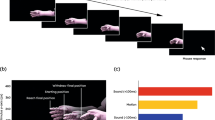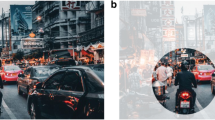Abstract
Proprioception of hand orientation (orientation production using the hand) is compared with manual matching of visual orientation (visual surface matching using the hand) in two experiments. In experiment 1, using self-selected arm postures, the proportions of wrist and elbow flexion spontaneously used to orient the pitch of the hand (20 and 80%, respectively) are relatively similar across both manual matching tasks and manual orientation production tasks for most participants. Proprioceptive error closely matched perceptual biases previously reported for visual orientation perception, suggesting calibration of proprioception to visual biases. A minority of participants, who attempted to use primarily wrist flexion while holding the forearm horizontal, performed poorly at the manual matching task, consistent with proprioceptive error caused by biomechanical constraints of their self-selected posture. In experiment 2, postural choices were constrained to primarily wrist or elbow flexion without imposing biomechanical constraints (using a raised forearm). Identical relative offsets were found between the two constraint groups in manual matching and manual orientation production. The results support two claims: (1) manual orientation matching to visual surfaces is based on manual proprioception and (2) calibration between visual and proprioceptive experiences guarantees relatively accurate manual matching for surfaces within reach, despite systematic visual biases in perceived surface orientation.








Similar content being viewed by others
References
Bingham GP, Pagano CC (1998) The necessity of a perception-action approach to definite distance perception: Monocular distance perception to guide reaching. J Exp Psychol Human 24:145–168
Bingham GP, Zall F, Robin D, Shull JA (2000) Distortions in definite distance and shape perception as measured by reaching with and without haptic feedback. J Exp Psychol Human 26:1436–1460
Bridgeman B, Hoover M (2008) Processing spatial layout by perception and sensorimotor interaction. Q J Exp Psychol 61:851–859
Cruse H (1986) Constraints for joint angle control of the human arm. Biol Cybern 54:125–132
Cruse H, Bruwer M (1987) The human arm as a redundant manipulator: the control of path and joint angles. Biol Cybern 57:137–144
Darling WG (1991) Perception of forearm angles in 3-dimensional space. Exp Brain Res 87:445–456
Dassonville P, Bridgeman B, Bala JK, Thiem P, Sampanes A (2004) The induced Roelofs effect: two visual systems or the shift of a single reference frame? Vision Res 44:603–611
Dick M, Hochstein S (1989) Visual orientation estimation. Percept Psychophys 46:227–234
Durgin FH (2009) When walking makes perception better. Curr Dir Psychol Sci 18:43–47
Durgin FH, Li Z (2011a) The perception of 2D orientation is categorically biased. J Vis 11(8):13 (1–10)
Durgin FH, Li Z (2011b) Perceptual scale expansion: an efficient angular coding strategy for locomotor space. Atten Percept Psychophys 73:1856–1870
Durgin FH, Li Z (in press) Spatial biases and the haptic experience of surface orientation. In El Saddik A (ed) Haptics. InTech
Durgin FH, Hajnal A, Li Z, Tonge N, Stigliani A (2010a) Palm boards are not action measures: an alternative to the two-systems theory of geographical slant perception. Acta Psychol 134:182–197
Durgin FH, Li Z, Hajnal A (2010b) Slant perception in near space is categorically biased: evidence for a vertical tendency. Atten Percept Psychophys 72:1875–1889
Durgin FH, Hajnal A, Li Z, Tonge N, Stigliani A (2011) An imputed dissociation might be an artifact: further evidence for the generalizability of the observations of Durgin et al. 2010. Acta Psychol 138:281–284
Fisher GH (1968) The frameworks for perceptual localization. Technical report No. 70/GEN/9617, University of Newcastle upon Tyne
Flanders M, Soechting JF (1995) Frames of reference for hand orientation. J Cogn Neurosci 7:182–195
Fuentes CT, Bastian AJ (2010) Where is your arm? Variations in proprioception across space and tasks. J Neurophysiol 103:164–171
Gentaz E, Baud-Bovy G, Luyat M (2008) The haptic perception of spatial orientations. Exp Brain Res 187:331–348
Gibson JJ (1979) The ecological approach to visual perception. Houghton Mifflin, Boston
Gibson JJ, Cornsweet J (1952) The perceived slant of visual surfaces-optical and geographical. J Exp Psychol 44:11–15
Goodale MA, Milner AD (1992) Separate visual pathways for perception and action. Trends Neurosci 15:20–25
Haffenden AM, Goodale MA (1998) The effect of pictorial illusion on prehension and perception. J Cogn Neurosci 10:122–136
Hajnal A, Abdul-Malak DT, Durgin FH (2011) The perceptual experience of slope by foot and by finger. J Exp Psychol Human 37:709–719
Harris CS (1963) Adaptation to displaced vision: visual, motor, or proprioceptive change? Science 140:812–813
Held R, Freedman SJ (1965) Plasticity in human sensorimotor control. Science 142:455–462
Howe CQ, Purves D (2005a) Natural-scene geometry predicts the perception of angles and line orientation. Proc Natl Acad Sci USA 102:1228–1233
Howe CQ, Purves D (2005b) The Muller-Lyer illusion explained by the statistics of image-source relationships. Proc Natl Acad Sci USA 102:1234–1239
Howe CQ, Lotto RB, Purves D (2006) Comparison of Bayesian and empirical ranking approaches to visual perception. J Theor Biol 241:866–875
Jastrow J (1892) Studies from the University of Wisconsin: on the judgment of angles and the position of lines. Am J Psychol 5:214–248
Jeannerod M (1988) The neural and behavioural organization of goal directed movements. Oxford University Press, Oxford, p 283
Kappers AML (1999) Large systematic deviations in the haptic perception of parallelity. Perception 28:1001–1012
Lackner JR, DiZio PA (2000) Aspects of body self-calibration. Trends Cogn Sci 4:279–288
Li Z, Durgin FH (2009) Downhill slopes look shallower from the edge. J Vis 9(11):6 (1–15)
Li Z, Durgin FH (2010) Perceived slant of binocularly viewed large-scale surfaces: a common model from explicit and implicit measures. J Vis 10(14):13 (1–16)
Li Z, Durgin FH (2011) Design, data and theory regarding a digital hand inclinometer: a portable device for studying slant perception. Behav Res Methods 43:363–371
Li Z, Phillips J, Durgin FH (2011) The underestimation of egocentric distance: evidence from frontal matching tasks. Atten Percept Psychophys 73:2205–2217
Loomis JM, Da Silva JA, Fujita N, Fukusima SS (1992) Visual space perception and visually guided action. J Exp Psychol Human 18:906–921
McIntyre J, Lipshits M (2008) Central processes amplify and transform anisotropies of the visual system in a test of visual-haptic coordination. J Neurosci 28:1246–1261
Milner AD, Goodale MA (1995) The visual brain in action. Oxford University Press, Oxford
Norman JF, Todd JT, Phillips F (1995) The perception of surface orientation from multiple sources of optical information. Percept Psychophys 57:629–636
Norman JF, Crabtree CE, Bartholomew AN, Ferrell EL (2009) Aging and the perception of slant from optical texture, motion parallax, and binocular disparity. Atten Percept Psychophys 71:116–130
Powers WT (1973) Behavior: the control of perception. Aldine, Chicago
Proffitt DR, Bhalla M, Gossweiler R, Midgett J (1995) Perceiving geographical slant. Psychon B Rev 2:409–428
Rieser JJ, Ashmead DA, Taylor C, Youngquist G (1990) Visual perception and the guidance of locomotion without vision to previously seen targets. Perception 19:675–689
Rosenbaum DA, Loukopoulos LD, Meulenbroek RG, Vaughan J, Engelbrecht SE (1995) Planning reaches by evaluating stored postures. Psychol Rev 102:28–67
Rossetti Y, Meckler C, Prablanc C (1994) Is there an optimal arm posture? Deterioration of finger localization precision and comfort sensation in extreme arm-joint postures. Exp Brain Res 99:131–136
Schot WD, Brenner E, Smeets JB (2010) Posture of the arm when grasping spheres to place them elsewhere. Exp Brain Res 204:163–171
Sedgwick HA (1986) Space perception. In: Boff KR, Kaufman L, Thomas JP (eds) Handbook of perception and human performance. Wiley, New York, pp 21.1–21.57
Smeets JB, Van den Dobbelsteen JJ, De Grave DD, Van Beers RJ, Brenner E (2006) Sensory integration does not lead to sensory calibration. Proc Nat Acad Sci USA 103:18781–18786
Soechting JF, Buneo CA, Herrmann U, Flanders M (1995) Moving effortlessly in three dimensions: does Donders’ law apply to arm movement? J Neurosci 15:6271–6280
Todd JT, Thaler L, Dijkstra TM (2005) The effects of field of view on the perception of 3D slant from texture. Vision Res 45:1501–1517
van Beers RJ, Sittig AC, Denier van der Gon JJ (1998) The precision of proprioceptive position sense. Exp Brain Res 122:367–377
Von Helmholtz H (1867) Handbuch der physiologischen Optik, vol 1. Voss, Lelpzig, pp 601–602
Wang X (1999) Three-dimensional kinematic analysis of influence of hand orientation and joint limits on the control of arm postures and movements. Biol Cybern 80:449–463
Wilson ET, Wong J, Gribble PL (2010) Mapping proprioception across a 2D horizontal workspace. PLoS ONE 5(7):e11851
Wundt W (1862) Beiträge zur Theorie der Sinneswahrnehmung. Winter’sche Verlagshandlung, Leipzig
Acknowledgments
This research was supported by Award Number R15 EY021026-01 from the National Eye Institute. The content is solely the responsibility of the authors and does not necessarily represent the official views of the National Eye Institute or the National Institutes of Health.
Author information
Authors and Affiliations
Corresponding author
Rights and permissions
About this article
Cite this article
Li, Z., Durgin, F.H. Manual matching of perceived surface orientation is affected by arm posture: evidence of calibration between proprioception and visual experience in near space. Exp Brain Res 216, 299–309 (2012). https://doi.org/10.1007/s00221-011-2934-2
Received:
Accepted:
Published:
Issue Date:
DOI: https://doi.org/10.1007/s00221-011-2934-2




